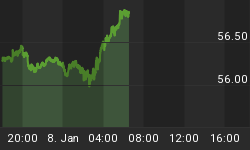Tuesday's bright start to equities was tarnished by selling in the last couple of hours. Overnight, the market had moved higher on the usual reasoning about how the market is oversold, undervalued, unloved, and that everyone is too bearish even though most people are telling the bullish story. Sunshine disinfects, though, and the highs for the day were set during the optimistic first half-hour.
Neither stocks nor bonds responded to the modest shortfall in Retail Sales from expectations. The print of +0.2%, +0.2% ex-auto, was the second-weakest reading of the year, and a mild surprise; however, as has been true for some time economic data was ignored. The focus was ostensibly on the Fed and a result that few thought would be surprising. That's why it was curious to see currency markets trading rather sharply. The dollar index rose to nearly the highest level of the year, with the Euro off nearly four big figures since Friday. What is more, despite the dollar strength and equity weakness, commodities rallied. This is an unusual combination. In fact, the last time that the S&P fell at least as much as it did today (-0.9%), the dollar index rallied at least as much as it did today (+1.0%), and the DJ-UBS Commodity index rallied at least as much as it did today (+0.6%) was in February 2009.
There was some speculation that the odd mid-day timing of the Euro breakdown might have had something to do with the S&P downgrade announcements, which are due any day now. Apparently, under the new rules controlling rating agency behavior in Europe, they are required to report ratings changes to regulators twelve hours before formally announcing the change (I hadn't known this), and there was suspicion that there was a leak. We're all pretty sure which direction the changes will be in, but the actual report will still cause some ripples in an illiquid year-end market.
As of this writing, S&P has made no announcement, but we have all night.
I think this is a more likely explanation for the market action than attributing the moves to the FOMC announcement. There were no surprises in the statement or lack of action. Personally, it seems to me like the Fed is trying to coast on autopilot through the Andes Mountains, but no one was seriously expecting any change in policy; at most, some people expected a statement about how the communications policy will change going forward. So I don't think that's why the markets were moving (besides, the bond market rally was at 1pm, and nominally charged to a strong 10-year note auction, while the Fed statement wasn't until after 2pm).
Equity volume was a bit higher than recent standards, but liquidity is going to be an issue if there are any surprises over the next couple of weeks - for example, if Italy's auction on Wednesday is not well-received or if S&P downgrades France the full two notches rather than only one. This is mostly a year-end issue, but as I have pointed out all year, equity volumes this year have been consistently lower than in prior years. The following chart shows cumulative NYSE Composite Volume through the first 240 trading days of the year. The volumes leading up to and since the Volcker Rule assault on dealer market-making abilities (aka "proprietary risk taking") have been demonstrably lower than in the four years prior. I am sure there are other secular pressures on equity volumes, but in any event it seems obvious that we are in an era of less volume and diminishing market liquidity. (This should by the way favor small investment managers, who have lower market-impact costs of trading...which is another trend I see continuing.)

Source: Bloomberg. Equity volumes have been consistently weak all year.
10-year real yields are at their lowest levels ever (-0.087%), save for a spike down back in August. And that's happening despite the fact that a TIPS auction is only two days away and we would ordinarily expect prices to be backing up (especially with year-end liquidity!). But the chart below explains part of the dynamic. As European inflation-indexed bonds are being beaten up because of credit issues, TIPS are clearly deriving some support. Actually, although French real yields around 1.5% are not exactly cheap, they're pretty cheap if France is only downgraded one notch to match the U.S. rating. A few days ago they were over 2%. Once the French downgrade announcement is actually made, that is one place I would look to add exposures. I would, however, continue to avoid Italy at 6% real yields. Greek 2025 inflation-linked bonds at a 21.5% real yield and a price of around 20...if the prices on Bloomberg mean anything...actually might be worth buying for the negative miracle.

Source: Enduring Investments. 1.5% real yields in Europe doesn't sound so bad,
especially for a US investor who doesn't currency-hedge.
The economic calendar on Wednesday is thin, so keep an ear out for pings from S&P and otherwise, enjoy the seasonal cashews.
















